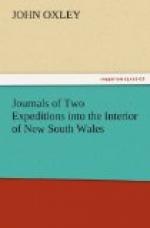October 23.—The storm continued through the night. Late in the morning we had intervals of fine weather, when all our strength was immediately despatched to bring up our little boat, as we found that we could not cross without its aid. When the people returned with the boat, it blew with such violence that we dared not venture to cross in her. We however moved a little nearer the point of entrance, to be more conveniently situated when the weather should clear up. The men voluntarily undertook to carry the boat on their shoulders until we should pass Port Stephens—a service, reduced as their strength was by constant exertion, I should have been unwilling to impose on them, however it might facilitate our future progress.
October 24.—The weather was so extremely unfavourable (blowing in violent squalls with almost constant rain), that it was near dark before we got every thing safely over. I had sent on in the morning to examine the beach for a few miles, and another inlet was discovered about four miles in advance. We named this lake Farquhar’s Lake, after Sir Walter.
October 25.—From the southern point of entrance into this lake the following bearings were taken. The highest part of the South Brother, north 6. E.; ditto North Brother, north 18. E.; Cape Hawke, south 3. E. We set forward at our usual hour. At a mile along the beach we found the wreck of a small vessel, which was recognised to be the Jane, of Sydney, belonging to Mills, before mentioned as the owner of the boat in our possession. It being low water when we arrived at the lagoon seen yesterday, we crossed it at the mouth, without unlading the horses. We proceeded along the beach for six or seven miles farther, when we turned off to the westward to cut off a point of land, and entered an excellent rising forest country, with rich thick brushes, bordering the coast line. We travelled in the whole about nine miles and a half, and halted about three quarters of a mile from the beach, from a point of which (one mile south-south-east of us), we saw Cape Hawke bearing east 73. S., distant six or eight miles; and at the extremity of a long curving sandy beach, about six miles west of the same point, there was an opening which, from the appearance of the country, we thought might probably form a lake.
October 26.—Two miles and a half farther travelling brought us again on the beach, along which we went for near seven miles more, when the opening or lake seen from the point yesterday obliged us to make use of our boat. On the opposite side to us we saw the wreck of the brig Governor Hunter, now nearly covered with sand, at high water the tide washing over her. We had got the horses and great part of the luggage safely over, and I was on the point of setting out to look for a place to turn the horses on (the immediate margin of the bay being a swampy brush); when an alarm was given, that the natives had speared one of the people. Previous to crossing,




